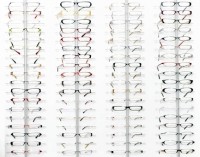What makes glasses so expensive? Oblong plastic lenses? Plastic and metal frames? No, we’re getting screwed!
 Those of us who need prescription eyewear need prescription eyewear. Are you wearing yours to read this? Imagine if you weren’t. Imagine life without your glasses for a year, a week, an hour. Yet many health insurance plans, especially for the unemployed or self-employed, don’t cover them.
Those of us who need prescription eyewear need prescription eyewear. Are you wearing yours to read this? Imagine if you weren’t. Imagine life without your glasses for a year, a week, an hour. Yet many health insurance plans, especially for the unemployed or self-employed, don’t cover them.
Mine doesn’t.
Last year, I went shopping for no-line progressive bifocals in small oval metal frames. Name brands mean nothing to me. Price does. My high astigmatism and need for bifocals disqualify me from those buy-one-get-one-free deals, which almost always involve only single-vision specs.
In store after store, megachains and optical boutiques alike, small oval metal frames fitted with lenses matching my prescription started at $300. One popular shop quoted me $582 for the lenses alone.
I bought a pair of no-line progressive bifocals in small oval metal frames for $44 online. I’m wearing them right now.
Perhaps because prescription glasses are where medicine meets fashion, they’re among the world’s most overpriced merchandise. Imperfect eyesight isn’t your fault: You can’t make yourself nearsighted by eating too much fudge. Yet if your health plan excludes vision care, you’ve spent years at the mercy of a $64 billion industry characterized by 500-percent markups.
 This has begun to change over the last few years. A knowledge-is-power, power-to-the-people, Web-driven DIY wave is rocking the optical industry’s very foundations. Dozens of companies now sell prescription glasses online, frames and lenses included, for as little as $7.95.
This has begun to change over the last few years. A knowledge-is-power, power-to-the-people, Web-driven DIY wave is rocking the optical industry’s very foundations. Dozens of companies now sell prescription glasses online, frames and lenses included, for as little as $7.95.
It works like this: Google “cheap glasses” to find a frame you like at a price you like at a site you like. (Among the most popular are 39DollarGlasses, ZenniOptical — where I bought mine — and Goggles4U.) Use the virtual fitting mechanism to “try it on.” Type in your prescription (obtained from an actual eye doctor), pupillary distance (aka PD, derived by measuring the space between your pupils with a ruler), address and payment information. Send.
 It’s a virtual myopian/hyperopian/presbyopian Tea Party, led largely by Minnesota software engineer Ira Mitchell, who launched his revolutionary GlassyEyes blog (its motto is “Saving the World from Overpriced Glasses!”) in 2006. Packed with forums, product reviews, discount deals, and tips for buying specs online, it’s the vision-impaired version of Yelp.
It’s a virtual myopian/hyperopian/presbyopian Tea Party, led largely by Minnesota software engineer Ira Mitchell, who launched his revolutionary GlassyEyes blog (its motto is “Saving the World from Overpriced Glasses!”) in 2006. Packed with forums, product reviews, discount deals, and tips for buying specs online, it’s the vision-impaired version of Yelp.
“There is no appreciable functional or material difference” between prescription eyewear bought online and bought in brick-and-mortar stores, Mitchell tells me, but in stores “the cost to the consumer is anywhere from four to ten times more. It turns out that they’re making ridiculous margins on the frames, the lenses and the coatings.”
Complete with antiscratch coatings and other pluses, his own glasses cost between $30 and $60 per pair online. Over the last three years, he’s bought around 40 pair — because, at that price, he can.

Mitchell was appalled when he first began researching wholesale prices for optical merchandise and realized that opticians acquire lenses for as little as $3 each. “I’ve easily paid twenty times that when I didn’t know any better,” he says.
Granted, these glass, plastic, polycarbonate or polymer blanks must be ground to fit frames and prescriptions, and this takes work, but it’s not rocket science. Typically, lens grinding is done by optical laboratory technicians. According to PayScale.com, OLTs in the United States earn between $9.73 and $14.40 per hour. Most learn on the job, and have only a high-school diploma or a GED. No specific certification is required.
The fleecing, Mitchell says, is just as bad on frames.
“A consumer-level frame costs significantly less than $10 to manufacture. The rest is operations, licensing and profit. Think about that the next time you pick up an average $150 frame. These aren’t markedly different or superior to the $30 glasses available from reputable online dealers — and those include lenses, probably the same ones you were just about to pay $200 for in the store.”

A key to the industry-standard overpricing is the fact that a single corporation — Luxottica, the world’s largest eyewear firm — owns many retail eyewear chains and many popular eyewear brands. Based in Milan, Italy, Luxottica owns and operates LensCrafters, Sears Optical, Target Optical, Pearle Vision, Sunglass Hut, Ilori, and other chains in the United States, along with yet more chains throughout Asia, Europe, Africa, India, the Antipodes and the Middle East.
Luxottica owns Ray-Ban, Oakley, Oliver Peoples, Vogue, and other brands, and makes glasses under license for over a dozen designer labels including Versace, Prada, Bulgari, DKNY, Burberry, Ralph Lauren, Dolce & Gabbana, Donna Karan, Tiffany, and more. As if that isn’t enough, Luxottica is also the parent company of a vision-care benefits program, EyeMed.

Eyewear prices in brick-and-mortar stores stay artificially high, Mitchell says, due to “the lack of real competition, inasmuch as Luxottica owns massive manufacturing, licensing, retailing and insurance interests” — albeit EyeMed is “not so much insurance as a marketing ploy to get people to buy from their stores at a discount and to force the remaining independent stores to buy Luxottica controlled frames. But, again, most people are unaware of this.”
Because one company holds a near-monopoly on brick-and-mortar eyewear stores, “pricing models are somewhat static across the lot of them. They also have a knack for using the mattress sale model … constantly running sales that seem too good to pass up when in reality they’re still making enormous profits.”

“Semi-Annual 50% Off Sales Event,” reads a current LensCrafters ad. But the frames in question range from around $100 to around $300, and that’s without lenses.
“People pay what the brick-and-mortars are asking, primarily because the vast majority don’t know there are better, cheaper options,” Mitchell says.
As with any purchase — in fact more than with most purchases, as this involves eyesight — it pays to research each company’s delivery and return policies, Better Business Bureau status, and accessibility. Does its Web site list a phone number? If not, why not? If so, call it. Can you reach live people? Are they knowledgeable about your prescription? Does the company have its own in-house optometrists? It should. If you care about brand names, can you ascertain that the logo-bearing frames sold by any given company aren’t counterfeits? Factories churn out fakes.
While many online outfits sell real and bogus designer frames, the least expensive frames available online are unapologetically nameless generics: current and classic styles, sans logo. As is true with most consumer products, they’re not necessarily worse than their name-brand counterparts. After a year-plus of daily use, my $44 generics still look new. (That being said, I should have paid a few dollars more for higher-quality polycarbonate lenses and I should have sought bifocals with a wider middle-vision band, but these errors were my own, not the company’s.)
 “Very high-priced frames may have somewhat better materials,” Mitchell says, “but from my experience, the no-names have been very well made.” Having owned dozens of generic pairs, he’s experienced “no more issues with them than with the name brands from LensCrafters. I think they’re pretty much on par.”
“Very high-priced frames may have somewhat better materials,” Mitchell says, “but from my experience, the no-names have been very well made.” Having owned dozens of generic pairs, he’s experienced “no more issues with them than with the name brands from LensCrafters. I think they’re pretty much on par.”
These days, he notes, “there are a lot more online retailers now than at the end of 2006. There aren’t a whole lot more reputable ones, however. I’ve shopped at over a dozen, and narrowed things down to about three or four that I feel comfortable recommending to others. As this is a fully custom market, mistakes can enter the process anywhere from the initial customer entering prescription information to the production process. I’ve found that a few of the sites do a better job than others at fixing mistakes. Some do better at this than the traditional stores.
“Prices haven’t dropped at all in the traditional brick-and-mortars, but downward price pressure from Wal-Mart will undoubtedly start to make an impact in certain parts of the country. I saw a sign in a Wal-Mart recently for $38 glasses. The selection was tiny, but we’re starting to see a price intersection.”
 The first online eyeglasses company was Houston-based FramesDirect. In 1992, optometrists Dhavid Cooper and Guy Hodgson closed their several Texas brick-and-mortar shops, then pondered their future.
The first online eyeglasses company was Houston-based FramesDirect. In 1992, optometrists Dhavid Cooper and Guy Hodgson closed their several Texas brick-and-mortar shops, then pondered their future.
“We knew that we wanted to sell eyewear in all fifty states 24 hours a day, seven days a week, 365 days a year,” Hodgson says. “We had no idea how to do this.” Renting a small office, they installed computers.
“When you talked about the Internet in those days, no one knew what you meant. Search engines were in their absolute infancy. We thought a 56k modem was blisteringly fast.”

Cooper had won a Surgeon General’s Commendation Award in his native South Africa for creating a program providing the poor with recycled glasses for free. Hodgson specialized in treating the nearly blind. Barely fluent in email, the pair created a basic Web site, offering designer glasses at low prices because, unlike brick-and-mortar opticians, they needed to pay neither storefront rent nor employees’ salaries, nor did they need to keep large quantities of merchandise in stock.
“Everyone around us thought we were completely mad: Eye doctors, giving up their lucrative practices to go into this weird thing,” Hodgson laughs. But once orders started pouring in, “The whole optical industry completely shunned us. They said we were ruining them.”
At eyewear conventions, he and Cooper wore their nametags backward to avoid verbal abuse. Since then, dozens of imitators have emerged, many based overseas and most able to offer even lower prices because they sell generics. Buying prescription eyewear is like buying prescription drugs: It’s cheaper online. It’s cheaper when it comes from outside the U.S. GlassesUnlimited, for instance, can afford to sell hundreds of different stylish frames fitted with prescription lenses for only $9.99 because its entire operation is based in Thailand.
“We don’t have big margins here. That’s how we are serving our clientele. That’s why we’re getting hundreds of orders on a daily basis, 70 percent of which come from the U.S. and Canada,” GU manager Sam Davis tells me. “We have virtually no expenses. We have our own home brand and do our own production. We don’t outsource anything.”
Based in the U.S., FramesDirect still undercuts retail-store prices for guaranteed designer goods.
“What we sell and what the brick-and-mortar stores sell are the exact same products,” Guy Hodgson says. “How can they afford to charge the prices they charge?”
About Anneli Rufus

Anneli Rufus is the author of several books, most recently The Scavenger’s Manifesto (Tarcher Press, 2009). Read more of Anneli’s writings on scavenging at scavenging.wordpress.com.
Editor’s note: This article was originally published by Alternet and was republished here with the authors generous permission.


Rarely have I read a less informed & less informative article.
The ramblings are too long to hit all the misinformation, so just a few glaring mistakes:
1. The #1 cost in a pair of glasses is employees. American workers. Unemployment is around 10%. Do you prefer 20%? OK, save on employee cost and your taxes go up covering the people you had fired so you could buy glasses overseas. You saved nothing & now less Americans have income to buy YOUR products.
2. There IS a huge difference in lenses & frames.You wrote that your #1-only consideration is price. That is generated from ignorance. There is a difference. A “Varilux” Brand No-Line Progressive Bifocal and a “Kodak” progressive are vastly superior in multiple ways. You picked cheap versus best vision. You don’t know all you are missing-if you had better vision you may have not missed seeing so much!
3. Yes, Lenscrappers is twice, three times higher than other opticals, but there exist thousands of local opticals not ripping people off without sending your business overseas and raising both of our taxes as you unemploy Americans.
4. There are huge frame differences. The cheap overseas frames have metal coatings that wear off in a year. What happened to the worn off coating? It’s in your liver & pancreas. Toxic chromium, aluminum, zinc, nickle all floating through your blood stream. Did you save enough with your cheap glasses to pay for pancreatic cancer? If the Chinese hid the toxic chemicals in your pet’s food and children’s milk & formula, would they not have put any chemicals into your eyeglass frame?
Your article has caused harm to the consumer.
You make a good point in that buying cheap stuff from overseas potentially puts Americans out of work, and I’m as worried about American unemployment as the next person.
And yes, products made in Chinese factories are often full of hidden toxins. This is something we all need to be more aware of and about which we all need to educate ourselves. (But hidden toxins are also in the vast majority of products sold right here at home. I’m working on a story right now about cosmetics — scary!!)
It’s true that expensive glasses from local shops can often provide better vision to some customers at a much higher price. But some customers — especially those without eye-care insurance — simply can’t afford those prices. For them, a $50 pair of glasses in their new prescription purchased online is better than either $500 glasses that their insurance won’t cover or a five-year-old pair of glasses in their old prescription that they couldn’t otherwise afford to replace.
Also, some of the online eyeglasses companies, such as FramesDirect, are based entirely in the US and all their employees are here in the US. By seeking out such companies, customers can still support the US economy.